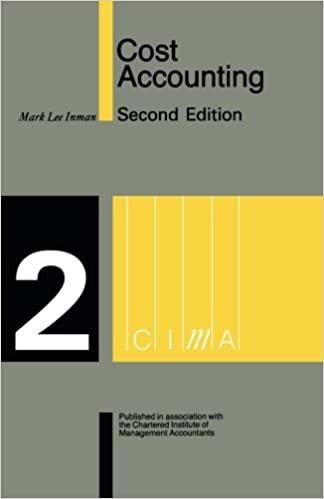Question
Eugene Brewing Company is budgeting for the next year. The following is the companys beginning balance sheet: EUGENE BREWING COMPANY BALANCE SHEET 12/31/2020 Assets Cash
Eugene Brewing Company is budgeting for the next year. The following is the companys beginning balance sheet:
| EUGENE BREWING COMPANY BALANCE SHEET 12/31/2020 | |
|
Assets Cash $ 160,000 Accounts receivable 120,000 Inventory 160,000 Total current assets $ 440,000
Fixed assets 880,000 Accumulated depreciation (300,000) Total Fixed Assets Net 580,000
Total Assets $1,020,000 |
Liabilities and Equities Accounts payable $ 200,000 Long-term debt 350,000
Total liabilities $ 550,000
Common stock at par $ 150,000 Additional paid-in 150,000 Retained earnings 170,000 Total Equity 470,000 Total liabilities and equities $1,020,000 |
The company expects to collect the beginning balance of accounts receivable in January. In general, 40% of the companys sales are on a cash basis. Of the credit sales, 40% are paid in the following month, and 60% are paid in the second month after the sale.
The accounts payable at the beginning of the year must be paid in January. All materials are purchased on credit and paid for in the following month.
The long-term debt has an annual interest rate of 12%. Interest payments of 1% of the principal are made each month. The long-term debt is not due for another five years.
Eugene Brewing Company makes two different types of beer, an ale and a porter. The ale is a lighter beer that requires fewer ingredients than does the darker and heavier porter. The input requirements for a case of beer for each type of beer is as follow:
| For Making Ale | ||
| Material | Quantity per case | Cost |
| Hops | 5 lb. | $0.50/lb. |
| Yeast | 1 oz. | 0.20/oz. |
| Sugar | 0.5 lb. | 0.40/lb. |
| Bottles | 24 | 0.20/bottle |
| For Making Porter | ||
| Material | Quantity per case | Cost |
| Hops | 10 lb. | $0.50/lb. |
| Yeast | 1 oz. | 0.20/oz. |
| Sugar | 0.8 lb. | 0.40/lb. |
| Bottles | 24 | 0.20/bottle |
The labor to make a case of beer is the same for each type of beer, 0.20 hours at $20/hour. Labor is paid in the month earned. Monthly overhead expenses are paid in the month incurred and expected to be as follows:
| Electricity $ 75,000 Administrative 115,000 Indirect labor 65,000 Rent 70,000 Depreciation 80,000 |
Ale sells for $25 per case, and porter sells for $30 per case. Estimated sales (in cases) for Eugene Brewing to be as follows:
| Month Cases Ale Cases Porter | ||
| January | 18,000 | 24,000 |
| February | 19,000 | 26,000 |
| March | 25,000 | 28,000 |
| April | 24,000 | 30,000 |
The beginning inventory includes 13,000 cases of ale and 12,000 cases of porter. The company prefers to have inventory at the end of each month equal to the expected sales in the next month. Eugene Brewing uses a first-in, first-out (FIFO) method of costing inventory. The company must buy a new bottling machine for $480,000 at the end of January.
a. Estimate cash flows in each of the months.
b. Does the company need to borrow money in any of the months?
c. Make a balance sheet as of the end of March and an income statement for the first three months. Assume that the company borrows cash at an interest rate of 1% per month to make up any shortage of cash.
Step by Step Solution
There are 3 Steps involved in it
Step: 1

Get Instant Access to Expert-Tailored Solutions
See step-by-step solutions with expert insights and AI powered tools for academic success
Step: 2

Step: 3

Ace Your Homework with AI
Get the answers you need in no time with our AI-driven, step-by-step assistance
Get Started


